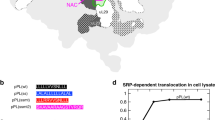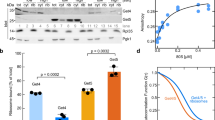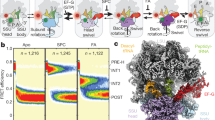Abstract
Approximately one-third of the proteome is initially destined for the eukaryotic endoplasmic reticulum or the bacterial plasma membrane1. The proper localization of these proteins is mediated by a universally conserved protein-targeting machinery, the signal recognition particle (SRP), which recognizes ribosomes carrying signal sequences2,3,4 and, through interactions with the SRP receptor5,6, delivers them to the protein-translocation machinery on the target membrane7. The SRP is an ancient ribonucleoprotein particle containing an essential, elongated SRP RNA for which precise functions have remained elusive. Here we used single-molecule fluorescence microscopy to show that the Escherichia coli SRP–SRP receptor GTPase complex, after initial assembly at the tetraloop end of SRP RNA, travels over 100 Å to the distal end of this RNA, where rapid GTP hydrolysis occurs. This movement is negatively regulated by the translating ribosome and, at a later stage, positively regulated by the SecYEG translocon, providing an attractive mechanism for ensuring the productive exchange of the targeting and translocation machineries at the ribosome exit site with high spatial and temporal accuracy. Our results show that large RNAs can act as molecular scaffolds that enable the easy exchange of distinct factors and precise timing of molecular events in a complex cellular process; this concept may be extended to similar phenomena in other ribonucleoprotein complexes.
This is a preview of subscription content, access via your institution
Access options
Subscribe to this journal
Receive 51 print issues and online access
$199.00 per year
only $3.90 per issue
Buy this article
- Purchase on Springer Link
- Instant access to full article PDF
Prices may be subject to local taxes which are calculated during checkout




Similar content being viewed by others
References
Keenan, R. J., Freymann, D. M., Stroud, R. M. & Walter, P. The signal recognition particle. Annu. Rev. Biochem. 70, 755–775 (2001)
Pool, M. R., Stumm, J., Fulga, T. A., Sinning, I. & Dobberstein, B. Distinct modes of signal recognition particle interaction with the ribosome. Science 297, 1345–1348 (2002)
Halic, M. et al. Following the signal sequence from ribosomal tunnel exit to signal recognition particle. Nature 444, 507–511 (2006)
Schaffitzel, C. et al. Structure of the E. coli signal recognition particle bound to a translating ribosome. Nature 444, 503–506 (2006)
Focia, P. J., Shepotinovskaya, I. V., Seidler, J. A. & Freymann, D. M. Heterodimeric GTPase core of the SRP targeting complex. Science 303, 373–377 (2004)
Egea, P. F. et al. Substrate twinning activates the signal recognition particle and its receptor. Nature 427, 215–221 (2004)
Becker, T. et al. Structure of monomeric yeast and mammalian Sec61 complexes interacting with the translating ribosome. Science 326, 1369–1373 (2009)
Peluso, P., Shan, S. O., Nock, S., Herschlag, D. & Walter, P. Role of SRP RNA in the GTPase cycles of ffh and FtsY. Biochemistry 40, 15224–15233 (2001)
Zhang, X., Rashid, R., Wang, K. & Shan, S. O. Sequential checkpoints govern substrate selection during cotranslational protein targeting. Science 328, 757–760 (2010)
Janda, C. Y. et al. Recognition of a signal peptide by the signal recognition particle. Nature 465, 507–510 (2010)
Batey, R. T., Rambo, R. P., Lucast, L., Rha, B. & Doudna, J. A. Crystal structure of the ribonucleoprotein core of the signal recognition particle. Science 287, 1232–1239 (2000)
Zhang, X., Kung, S. & Shan, S. O. Demonstration of a multistep mechanism for assembly of the SRP·SRP receptor complex: implications for the catalytic role of SRP RNA. J. Mol. Biol. 381, 581–593 (2008)
Shen, K. & Shan, S. O. Transient tether between the SRP RNA and SRP receptor ensures efficient cargo delivery during cotranslational protein targeting. Proc. Natl Acad. Sci. USA 107, 7698–7703 (2010)
Shen, K., Zhang, X. & Shan, S. O. Synergistic actions between the SRP RNA and translating ribosome allow efficient delivery of the correct cargos during cotranslational protein targeting. RNA 17, 892–902 (2011)
Estrozi, L. F., Boehringer, D., Shan, S., Ban, N. & Schaffitzel, C. Cryo-EM structure of the E. coli translating ribosome in complex with SRP and its receptor. Nature Struct. Mol. Biol. 18, 88–90 (2011)
Althoff, S., Selinger, D. & Wise, J. A. Molecular evolution of SRP cycle components: functional implications. Nucleic Acids Res. 22, 1933–1947 (1994)
Ataide, S. F. et al. The crystal structure of the signal recognition particle in complex with its receptor. Science 331, 881–886 (2011)
Ha, T. et al. Probing the interaction between two single molecules: fluorescence resonance energy transfer between a single donor and a single acceptor. Proc. Natl Acad. Sci. USA 93, 6264–6268 (1996)
Roy, R., Hohng, S. & Ha, T. A practical guide to single-molecule FRET. Nature Methods 5, 507–516 (2008)
McKinney, S. A., Joo, C. & Ha, T. Analysis of single-molecule FRET trajectories using hidden Markov modeling. Biophys. J. 91, 1941–1951 (2006)
Shan, S. O., Chandrasekar, S. & Walter, P. Conformational changes in the GTPase modules of the signal reception particle and its initiation of protein translocation. J. Cell Biol. 178, 611–620 (2007)
Shan, S. O., Stroud, R. M. & Walter, P. Mechanism of association and reciprocal activation of two GTPases. PLoS Biol. 2, e320 (2004)
Zhang, X., Schaffitzel, C., Ban, N. & Shan, S. O. Multiple conformational switches in a GTPase complex control co-translational protein targeting. Proc. Natl Acad. Sci. USA 106, 1754–1759 (2009)
Zhang, X. et al. Direct visualization reveals dynamics of a transient intermediate during protein assembly. Proc. Natl Acad. Sci. USA 108, 6450–6455 (2011)
Halic, M. et al. Signal recognition particle receptor exposes the ribosomal translocon binding site. Science 312, 745–747 (2006)
Hoskins, A. A., Gelles, J. & Moore, M. J. New insights into the spliceosome by single molecule fluorescence microscopy. Curr. Opin. Chem. Biol. 15, 864–870 (2011)
Lohman, T. M. & Bjornson, K. P. Mechanisms of helicase-catalyzed DNA unwinding. Annu. Rev. Biochem. 65, 169–214 (1996)
Yodh, J. G., Schlierf, M. & Ha, T. Insight into helicase mechanism and function revealed through single-molecule approaches. Q. Rev. Biophys. 43, 185–217 (2010)
Yuan, R. Structure and mechanism of multifunctional restriction endonucleases. Annu. Rev. Biochem. 50, 285–315 (1981)
Murray, N. E. Type I restriction systems: sophisticated molecular machines (a legacy of Bertani and Weigle). Microbiol. Mol. Biol. Rev. 64, 412–434 (2000)
Schaffitzel, C. & Ban, N. Generation of ribosome nascent chain complexes for structural and functional studies. J. Struct. Biol. 158, 463–471 (2007)
van der Sluis, E. O., Nouwen, N. & Driessen, A. J. SecY-SecY and SecY-SecG contacts revealed by site-specific crosslinking. FEBS Lett. 527, 159–165 (2002)
Ferré-D’Amaré, A. R. & Doudna, J. A. Use of cis- and trans-ribozymes to remove 5′ and 3′ heterogeneities from milligrams of in vitro transcribed RNA. Nucleic Acids Res. 24, 977–978 (1996)
Dalal, K. & Duong, F. Reconstitution of the SecY translocon in nanodiscs. Methods Mol. Biol. 619, 145–156 (2010)
Van den Berg, B. et al. X-ray structure of a protein-conducting channel. Nature 427, 36–44 (2004)
Mothes, W., Jungnickel, B., Brunner, J. & Rapoport, T. A. Signal sequence recognition in cotranslational translocation by protein components of the endoplasmic reticulum membrane. J. Cell Biol. 142, 355–364 (1998)
Duong, F. Binding, activation and dissociation of the dimeric SecA ATPase at the dimeric SecYEG translocase. EMBO J. 22, 4375–4384 (2003)
Powers, T. & Walter, P. Co-translational protein targeting catalyzed by the Escherichia coli signal recognition particle and its receptor. EMBO J. 16, 4880–4886 (1997)
Acknowledgements
We thank N. Ban and members of the Shan group for comments on the manuscript, C. Richards, L. Cai, T. Zhiyentayev, K. Lee and R. Zhou for help with RNC labelling and the instrument and software setup, and C.L. Guo, S. Kou and H. Lester for discussions. This work is supported by National Institutes of Health (NIH) grant GM078024 to S.-o.S., an NIH instrument supplement to grant GM45162 to D.C. Rees, and Caltech matching fund 350270 for the single-molecule instruments. S.-o.S. was supported by the Beckman Young Investigator award, the David and Lucile Packard Fellowship in Science and Engineering, and the Henry Dreyfus Teacher-Scholar award. T.H. was supported by National Science Foundation Physics Frontiers Centers program (08222613) and NIH grant GM065367.
Author information
Authors and Affiliations
Contributions
K.S., S.A., T.H. and S.-o.S. conceived the experiments. K.S. purified and labelled Ffh, FtsY, DNA, RNA and RNC. D.A. purified SecYEG and performed the GTPase assay in Fig. 4a. K.S. and S.A. carried out smFRET measurements under the direction of T.H. K.S. and S.A. analysed the data. K.S. and S.-o.S. wrote the paper with inputs from all other authors.
Corresponding author
Ethics declarations
Competing interests
The authors declare no competing financial interests.
Supplementary information
Supplementary Figures
This file contains Supplementary Figures 1-12. (PDF 7294 kb)
Rights and permissions
About this article
Cite this article
Shen, K., Arslan, S., Akopian, D. et al. Activated GTPase movement on an RNA scaffold drives co-translational protein targeting. Nature 492, 271–275 (2012). https://doi.org/10.1038/nature11726
Received:
Accepted:
Published:
Issue Date:
DOI: https://doi.org/10.1038/nature11726
This article is cited by
-
The Principles of Protein Targeting and Transport Across Cell Membranes
The Protein Journal (2019)
-
Cotranslational protein targeting to the membrane: Nascent-chain transfer in a quaternary complex formed at the translocon
Scientific Reports (2018)
-
Structure of the quaternary complex between SRP, SR, and translocon bound to the translating ribosome
Nature Communications (2017)
-
Protein export through the bacterial Sec pathway
Nature Reviews Microbiology (2017)
-
The signal recognition particle contacts uL23 and scans substrate translation inside the ribosomal tunnel
Nature Microbiology (2017)
Comments
By submitting a comment you agree to abide by our Terms and Community Guidelines. If you find something abusive or that does not comply with our terms or guidelines please flag it as inappropriate.



